

Zitierweise / cite as:
Payer, Alois <1944 - >: Chronik Thailands = กาลานุกรมสยามประเทศไทย. -- Chronik 1956 / B. E. 2499. -- Fassung vom 2017-03-23. -- URL: http://www.payer.de/thailandchronik/chronik1956.htm
Erstmals publiziert: 2013-04-29
Überarbeitungen: 2017-03-23 [Ergänzungen] ; 2017-01-10 [Ergänzungen] ; 2016-12-26 [Ergänzungen] ; 2016-09-21 [Ergänzungen] ; 2016-08-27 [Ergänzungen] ; 2016-05-21 [Ergänzungen] ; 2016-05-01 [Ergänzungen] ; 2016-04-21 [Ergänzungen] ; 2016-03-23 [Ergänzungen] ; 2016-02-21 [Ergänzungen] ; 2016-01-31 [Ergänzungen] ; 2016-01-08 [Ergänzungen] ; 2015-12-28 [Ergänzungen] ; 2015-11-12 [Ergänzungen] ; 2015-10-02 [Ergänzungen] ; 2015-09-12 [Ergänzungen] ; 2015-08-30 [Ergänzungen] ; 2015-08-20 [Ergänzungen] ; 2015-04-24 [Ergänzungen] ; 2015-04-06 [Ergänzungen] ; 2015-02-06 [Ergänzungen] ; 2014-10-28 [Ergänzungen] ; 2014-10-06 [Ergänzungen] ; 2014-09-24 [Ergänzungen] ; 2014-08-17 [Ergänzungen] ; 2014-02-28 [Ergänzungen] ; 2013-10-17 [Ergänzungen] ; 2013-10-08 [Ergänzungen] ; 2013-10-05 [Ergänzungen] ; 2013-09-30 [Ergänzungen] ; 2013-09-19 [Ergänzungen] ; 2013-09-16 [Ergänzungen] ; 2013-09-04 [Ergänzungen] ; 2013-06-04 [Ergänzungen] ; 2013-05-20 [Ergänzungen]
©opyright: Dieser Text steht der Allgemeinheit zur Verfügung. Eine Verwertung in Publikationen, die über übliche Zitate hinausgeht, bedarf der ausdrücklichen Genehmigung des Herausgebers.
Dieser Text ist Teil der Abteilung
Thailand von
Tüpfli's Global Village Library
ช้างตายทั้งตัวเอาใบบัวปิดไม่มิด
|
Gewidmet meiner lieben Frau Margarete Payer die seit unserem ersten Besuch in Thailand 1974 mit mir die Liebe zu den und die Sorge um die Bewohner Thailands teilt. |
|
Bei thailändischen Statistiken muss man mit allen Fehlerquellen rechnen, die in folgendem Werk beschrieben sind:
Die Statistikdiagramme geben also meistens eher qualitative als korrekte quantitative Beziehungen wieder.
|
1956

"Obwohl nach der bekanntesten Version die Ankunft des nächsten Buddha erst nach Ablauf einer 5000jährigen Frist geweissagt ist, hat das messianische Verlangen mitunter die Dauer bis zur Ankunft von Ariya Metteyya [พระศรีอริยเมตไตรย] vorverlegt. Zumindest wurde die Erwartung bevorstehender großer oder unheilvoller Ereignisse um das Jahr 2500 der buddhistischen Zeitrechnung besonders aktiviert. In den Zeitungen fanden sich metaphorische Anspielungen auf diese apokryphen buddhistischen Prophezeiungen. Besonders waren solche Vorstellungen in der thai-sprachigen Wochenzeitung "Bangkok Times" zu lesen. In der Ausgabe vom 6. Februar B.E. 2499 wurde von einer Versammlung von "Phu Wiset" [ผู้วิเศษ] berichtet, die im Hinblick auf diesen Zeitabschnitt magisch besonders wirksame Buddha-Statuetten herstellten. Außerdem hieß es, dass die Erscheinung von fünf in Thailand sehr verehrten Buddha-Standbildern, darunter der erst vor kurzem entdeckte "Goldene Buddha" in Wat Traimit [วัดไตรมิตรวิทยารามวรวิหาร], Bangkok, als Vorzeichen für die Ankunft von Ariya Metteyya zu werten sei.
Die Ausgabe vom 16. April B.E. 2499 prophezeite Katastrophen apokalyptischen Ausmaßes, wobei moderne naturwissenschaftliche Kenntnisse und traditionelle Glaubensinhalte auf teils abstruse Weise miteinander verwoben sind.
Die Ausgabe vom 7. Mai B.E. 2499 enthält die Prophezeiung der unmittelbar bevorstehenden Ankunft des künftigen Buddha, die Ausgabe vom 6. August B.E. 2499 berichtet schließlich sogar von seiner Geburt."
[Quelle: Skrobanek, Walter <1941 - 2006>: Buddhistische Politik in Thailand : mit besonderer Berücksichtigung des heterodoxen Messianismus. -- Wiesbaden : Steiner, 1976. -- 315 S. ; 24 cm. -- (Beiträge zur Südasienforschung ; 23). -- ISBN 3-515-02390-9. -- Zugl.: Heidelberg, Univ., Diss., 1972. -- S. 225, Anm. 2. -- Mit Erlaubnis des inzwischen verstorbenen Autors]
1956
Labour Act. Enthält minimale Arbeitsschutzbestimmungen und ermöglicht hemmungslose Ausbeutung der Arbeitskräfte.
1956 - 1957
Bangkok und Städte im Umland: Streikwellen und Vergewerkschaftlichung.
1956

Königin Rambai Barni (รำไพพรรณี, 1904 - 1984), die Witwe von Rama VII., ernennt Marschall Sarit Thanarat (สฤษดิ์ ธนะรัชต์, 1908 - 1963) und Polizeigeneral Pao Sriyanon (เผ่า ศรียานนท์, 1910 - 1960) zu Direktoren ihrer Firma.
1956 - 1957
Thammasat University (มหาวิทยาลัยธรรมศาสตร์) Wöchentliche Diskussionen und Vorlesungen linksradikaler Redner.
Abb.: Lage der Thammasat University (มหาวิทยาลัยธรรมศาสตร์)
[Bildquelle: OpenStreetMap. -- Creative Commons Lizenz (Namensnennung, share alike)]
1956
Phya Anuman Rajadhon (อนุมานราชธน, พระยา, 1888-1969) veröffentlicht einen Artikel über den wert einer ethnografischen Kulturanthropologie für Thailand:
"The potential value of cultural anthropology to Thailand (...) can be summarized under three headings:
- The study of anthropology provides a broader, yet relativistic perspective on things, thus serving to correct the excesses of hypernationalism and to promote understanding and friendship among individuals and nations.
- As the chief integrative social science and the discipline most closely concerned with cultural relativity, cultural anthropology has a special role to play in the adaptation for Thailand of subject matter and principles of all the social sciences.
- Cultural anthropology can provide the objective facts about our own culture needed for the selective control of culture change, so necessary for Thailand at this critical juncture."
[Zitiert in: Amyot, Jacques <1920 - >: remember Chula : memoirs of four decades of involvement in a Thai university, 1962-2002. -- Bangkok : Chulalongkorn University Social Research Institute, 2003. -- 307 S. : Ill. ; 26 cm. -- ISBN 9741325304. -- S. 23]
1956
In Bangkok gibt es mindestens 20 Likey-Theater (ลิเก). 1970 gibt es keines mehr.
Abb.: Likey (ลิเก), 2008
[Bildquelle: kwanz. -- https://www.flickr.com/photos/kwanzshop/2245688197/. -- Zugriff am 2016-04-21. -- Creative Commons Lizenz (Namensnennung)
1956
Das letzte Gesetz zum Verbot homosexueller Handlungen wird außer Kraft gesetzt. Grund: "das Gesetz zerstört die Würde der Nation" und wurde noch nie angewandt.
1956
Start des Rural Teacher Education Project, das Lehrer zur Entwicklungshilfe im ländlichen Raum befähigen soll.
1956
In 59 Tambon (ตำบล) (von 4926) werden Tambon-Räte (สภาตำบล) geschaffen.
"The tambon council [สภาตำบล] is composed of members specially elected by the people of each village (one member per village), plus the kamnan [กำนัน] and all village headmen as ex officio members. The district officer is chairman. An executive committee is composed of the kamnan (as chairman), the tambon doctor, and all village headmen, plus not more than five other members appointed by the district officer from among the headmasters of local schools or other qualified local persons. Together, the tambon council and the executive committee comprise the tambon administrative organization, which has the following stipulated statutory functions:
- maintenance of public peace and order;
- provision and maintenance of land and waterways;
- maintenance of cleanliness along roads and paths and on the public domain, including rubbish and garbage disposal;
- prevention and abatement of communicable diseases;
- prevention and abatement of public perils;
- promotion of public education;
- promotion and development of public livelihood;
- provision of clean water or waterworks, markets, abattoirs, docks, landings, cemeteries, and mortuaries;
- provision and maintenance of places for the care of the sick;
- provision and maintenance of electric works or illumination by other means;
- provision of meeting places, parks, and playgrounds; and
- promotion of religion, culture, morals, and social welfare.
From its inception, the tambon administrative organization has had its own budget and income. In practice, however, it has remained heavily dependent on grants-in-aid from the central government. For example, each sapha tambon was given a grant of only 10,000 baht ($500) a year. Constrained by such financial limits, the sapha tambon have not been very successful as self-governing bodies."
[Quelle: Morell, David ; Chai-anan Samudavanija [ชัยอนันต์ สมุทวณิช] <1944 - >: Political conflict in Thailand : reform, reaction, revolution. -- Cambridge, Mass. : Oelgeschlager, 1981. -- 362 S. : Ill. ; 24 cm. -- ISBN 0-89946-044-5. -- S. 1125f.]
1956

679 Thai-Muslime, die meisten aus Südthailand, sind zum Studium des Islam in Saudi Arabien (المملكة العربية السعودية):
Abb.: Lage von Saudi Arabien (المملكة العربية السعودية)
[Bildquelle: OpenStreetMap. -- Creative Commons Lizenz (Namensnennung, share alike)]
1956
Gründung des Armed Forces Staff College in Bangkok.
1956
Jorges Orgibet (1907-1986) und einige seiner Freunde gründen den Foreign Corespondents Club of Thailand (FCCT). Besonders während des Vietbnamkriegs wird dieser zu einem wichtigen Forum des Nachrichtenaustauschs.
Webpräsenz: http://www.fccthai.com/. -- Zugriff am 2011-11-04
1956
Thailand beginnt household registration certificates an Thai-Familien auszugeben. Bergvölker (Hill Tribes) sind davonj ausgeschlossen.
1956

Public Services of Chicaco berät Thai-Finanzbehörden bei der Einführung moderner betriebswirtschaftlicher Methoden. 1957 wird ein einheitliches System des Rechnungswesens eingeführt, 1959 ein zentrales System des Rechnungswesens.
1956
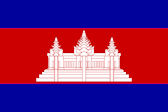
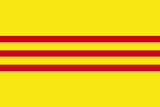
Es kommt zu Auseinandersetzungen zwischen Kambodscha und Thailand und Südvietnam. Thailand und Südvietnam hatten eine Wirtschaftsblockade errichtet und unterstützen rechtsgerichtete Khmer-Gruppen gegen die kambodschanische Regierung.
Abb.: Kambodscha, Thailand, Südvietnam
[Bildquelle: CIA. -- Public domain]
1956
Eröffnung von Central Wang Burapha (เซ็นทรัล วังบูรพา), dem ersten Einkaufszentrum Bangkoks mit Festpreisen (kein Feilschen!). Inhaber sind Tiang (เตียง จิราธิวัฒน์) und Samrit Chirathivat (สัมฤทธิ์ จิราธิวัฒน์).
"Central Department Store (Thai: สรรพสินค้าเซ็นทรัล) is a Thai department store chain, owned by Central Group. History
Started in 1927, 22-year old Nitiang or Tiang Chirathivat (เตียง จิราธิวัฒน์), an immigrant from mainland China, travels the sea and settles down in then Siam and started a store in Bangkok named "Keng Seng Lee" or (baskets for sale), which was the start of an emporium.[1]
Later that year, the store moved to Charoen Krung Road, in Bangkok's Si Phraya district. The store sold a large variety of local and international newspapers and magazines and carried the name "Central Trading Store". This was the first chapter of Central Department Stores' history.[1]
In the 1950s the company grew with more and more stores selling different items. It was one few stores in Bangkok that had the courage to order imported goods for sale and was the first to set up merchandising displays.[2]
In 1973 the Chidlom store opened under the new "one stop shopping" concept. Here customers could come to Central and buy everything they needed under one roof.[3]
In 1981 the Central Lad Ya Branch opened it doors and was the largest of its kind then.[4] Later in 1983 Central Plaza Lardprao opened it doors and was the largest shopping mall in Thailand at that time.[5]
On December 20, 2005, King Bhumibol Adulyadej conferred the company by Royal Warrant the royal Garuda emblem for its services.[6]
In the year 2010, Central operated 15 branches all over Thailand and planned to open even more stores in the near future.[7]"
[Quelle: http://en.wikipedia.org/wiki/Central_Department_Store. -- Zugriff am 2011-10-12]
1956
Abb.: Reklame für einen Gaskocher, 1956
1956

Eine 19-köpfige Delegation des Deutschen Bundestatgs besucht Thailand. Zu den Teilnehmern gehören
- Bundestagspräsident Eugen Karl Albrecht Gerstenmaier (CDU) (1906 - 1986)
- Bundestagsvizepräsident Carlo Johann Martin Heinrich Schmid (SPD) (1896 - 1979)
1956

Gründung der Toyota Motor Sales Co., Ltd., Bangkok Branch. Es ist die erste Toyota-Gesellschaft außerhalb Japans. Man importiert fertige PKws und Pickups, nämlich:
- TOYO-ACE
- STOUT
- MS 40
- DA
- LAND CRUISER
Abb.: Toyo-Ace der ersten Generation 1956
[Bildquelle: Mytho88 / Wikipedia. -- GNU FDLicense]
1956

Gründung der American Chamber of Commerce in Thailand (AMCHAM). Mitglieder: 8 amerikanische Unternehmen und ca. 60 US-Amerikaner.
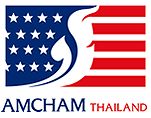
Abb.: ®Logo
1956

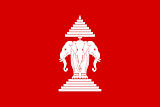
Auf Betreiben der Thai Regierung erhält die Thai Express Transport Organization (ETO) das Monopol für den Landtransport von US-Hilfsgütern (mili8tärische und andere) nach Laos. Dieses Monopol ist die wesentliche Quelle für den Reichtum von Air Vice Marshall Dawee Chullasapya (ทวี จุลละทรัพย์, 1914 - 1996).
1956

Im ersten Quartal fliegen zwei Sikorsky H-19 Hubschrauber der Thai Luftwaffe mit Thai-Personal vom Flughafen Wattay (ວັດໄຕ, Vientiane) aus Einsätze für die laotische Armee.
Abb.: Sikorsky H-19, 1950/1953
[Bildquelle: USAF / Wikimedia. -- Public domain]
Abb.: Lage von Wattay (ວັດໄຕ)
[Bildquelle: OpenStreetMap. -- Creative Commons Lizenz (Namensnennung, share alike)]
1956

Es erscheintStanton, Edwin F. <1901 - >: Brief authority : excursions of a common man in an uncommon world. -- New York : Harper, 1956. -- 290 S. ; 22 cm. -- Umschlag-Untertitel: "Recollections of China and Thailand". Der Verfasser war US-Gesandter in Thailand von 1946 bis 1953.
Abb.: Umschlagtitel der Ausgabe London, 1957
1956

Es erscheint:
Textor, Robert Bayard <1923 - 2013>: The northeastern samlor driver in Bangkok. -- In: The social implications of industrialization and urbanization : five studies of urban populations of recent rural origin in cities in Southern Asia / by by R. B. Textor [...] UNESCO Research Centre on the Social Implications of Industrialization in Southern Asia. -- Calcutta : UNESCO Research Centre on the Social Implications of Industrialization in Southern Asia, 1956.
"The Thai love of colour is flamboyantly demonstrated in the decoration of the samlor [สามล้อ]. The carriage of the vehicle is often black, but can come in any colour of the spectrum. The bars supporting the driver’s seat are usually painted in two or three variegated colours. The carriage is often embellished with trimmings in bright colours, and sometimes with a landscape, or cast statue of an animal from mythology. Upholstery, too, is many-hued. While older vehicles have only oil lamps for use at night, the newer models come equipped with battery-powered electric lamps. In addition to installing functional head and tail lights, some drivers drive for sheer decorative splendour of coloured lights - rear lights, side lights, axle lights, and lights raised on long wobbly stems. I have counted as many as sixteen lights on one vehicle. ... Samlor driving is a cruelly hazardous profession, and hardly a month goes by without an operator and often his passengers being run down and killed by motor vehicles. This danger has led to a response in magical terms. One sometimes notes small squares of gold leaf stuck onto the samlor body much as they might be attached to a Buddha image or guardian shrine, while on other vehicles one occasionally finds painted magical symbols of triangular or spiral design. (Samlormen, in common with many other Thai of traditional outlook, frequently wear charms suspended on necklaces, or bear magical tatoos to protect them from harm.)" (Textor 1956, p. 9-10.) [a.a.O., S. 9f. -- Zitiert in: Boesch, Ernst <1916 - 2014>: Zwiespältige Eliten : Eine sozialpsychologische Untersuchung über administrative Eliten in Thailand. -- Bern : Huber, 1970. -- 333 S. ; 21 cm. -- S. 210]
"Pedaling his vehicle up congested streets, the driver perhaps wonders whether today his life will be crushed out by a carelessly swerving truck or bus. The operator tries to remember and employ the arm signals for indicating turns. However, it is noteworthy that he usually neglects to look behind him when he pulls out toward the center of the street - where the faster automobiles move - in order to pass a pedestrian, a push-cart, or another samlor (Dreirad). This failure to look back is a main reason why the samlor profession is such a dangerous one. The existence of this maladaptive habit can be explained partly on ground that it would be irksome to look back over ones shoulder several thousand times a day. Moreover, a Buddhist-nurtured fatalism conspires with faith in one’s charm necklace or tatoo, to give one a feeling that collision is either unpreventable or unlikely." [a.a.O., S. 9f. -- Zitiert in: Boesch, Ernst <1916 - 2014>: Zwiespältige Eliten : Eine sozialpsychologische Untersuchung über administrative Eliten in Thailand. -- Bern : Huber, 1970. -- 333 S. ; 21 cm. -- S. 209f.]
1956

Es erscheint
Haas, Mary R. (Mary Rosamond) <1910 - 1996>: The Thai system of writing. -- Washington, American Council of Learned Societies, 1956. -- 115 S. ; 23 cm. -- (Publications series B-Aids ; 5). -- Eine Darstellung der Thai-Rechtschreibregeln
"In 1942 a small volume entitled "The Thai System of Writing" was prepared by the author. Reproduced by the Ditto process, it was used in Thai classes at the University of Michigan and later at the University of California, Berkeley. The present volume is a completely revised and rewritten version of that earlier work." [a.a.O., S. V]
Abb.: Einbandtitel
1956

Es erscheint einer der ersten Romane über das Rotlichtmilieu Bangkoks:Reynolds, Jack <1913 - 1984>: A Sort of Beauty : a novel. . -- London : Secker & Warburg, 1956. -- 328 S. -- Spätere Auflagen u.d.T. A woman of Bangkok. -- "A novel of an inexperienced young Englishman and the number one dancing girl of Siam"
Erscheint 1959 auf Deutsch:
Reynolds, Jack <1913 - 1984>: Versuchung in Bangkok : Roman. -- Hamburg : Rowohlt, 1959. -- 386 S. -- (rororo Taschenbuch ; 313/314)
Abb.: Einbandtitel
Abb.: Einbandtitel einer Taschenbuchausgabe
Abb.: Einbandtitel der deutschen Übersetzung
1956

Es erscheint:
Dooley, Thomas A. (Thomas Anthony) <1927 - 1961>: Deliver us from evil : the story of Viet Nam's flight to freedom. -- New York : Farrar, Straus, and Cudahy, 1956. -- 214 S. : Ill. -- "Experiences of an American Navy doctor in Indo-China after the fall of Dien Bien Phu". -- Dieses Buch von Tom Dooley beeinflusst die US Öffentlichkeit sehr für ein antikommunistisches, prokatholisches und prokapitalistisches Engagement in Vietnam.
Abb.: Umschlagtitel
"CHAPTER XVIII AFTERWORD
Why did the refugees feel about us, America, as they did in the years before Dien Bien Phu?
It should be remembered that every rumbling tank that overran the villages of the Tonkin, every blazing napalm bomb that seared the huts of the natives, every gun and jeep and truck and uniform that brought havoc upon the people in what they considered a “colonial” war—all these were “made in the U. S. A. ” The people of North Viet Nam considered the United States as a vast warehouse and supply depot for France’s colonialism, as indeed we were. I don’t know the exact figure, but it was in the hundreds of millions of dollars of aid, in military materials, to France for the war in Indo-China.
This equipment from us was laden with propaganda potential on both sides of the Bamboo Curtain. But only the Viet Minh Communists took the initiative. Perhaps it was because many Americans consider the word “propaganda” a dirty word. (“Information” is more acceptable. )
Perhaps it was because, by its very nature, the cogs of a democracy turn slowly. In any event, the Communists didn’t lose a moment.
The Viet Minh had a well-staffed and extremely effective psychological warfare department, under the leadership of General Giap [Võ Nguyên Giáp, 1911 - 2013], the man whose army conquered Dien Bien Phu. The propaganda was directed not at the leaders, not at the mandarins, not at the government heads, but it was directed at the common laborer of the delta. And the propaganda succeeded horribly well.
In the areas that had been under the Viet Minh control for five, six and seven years, the propaganda did little good. These people knew by the emptiness of their bellies that the Viet Minh was a fraud. The illness of the minds of their Communist re-educated children proved to them that the new system was evil—much more evil than France had ever been. But to those in the areas that had only been recently conquered, or turned over to the Viet Minh through the Geneva Treaty, Communism still held a fascination.
They were attracted by many of its ideas, especially the promise of land reforms. The people of Viet Nam had borne the burdens of colonialism for over eighty years and they were weary of them. The Communists offered the allurements of a “new way of life. ” The Democracies offered nothing, though they had the greatest things to offer— justice and freedom. I do not mean to imply that Communism was “voted” into power, but it did not meet with intelligent, or indeed any other kind of opposition.
The people from the two zones never met face to face.
One of the first rules of the conquering Communists was to restrict travel. As a consequence it was difficult to spread the truth about the “new way of life. ” And to those disillusioned people from the old zones who got through to unconquered ones the response would often be, “Well, when the Viet Minh liberate our areas it will be different. We shall work harder to produce the paradise that they have promised. The reason your province is in anguish is because you are too slow, you cannot work long hours, you take siestas, you do not toil the fields long enough. Things will be different when our province is rid of the French yoke.... ”
One might ask why, if they were so much in favor of the new rule, and if they so hated Americans as an extension of their French colonial rulers, did so many of them attempt to escape to Haiphong? The answer is simple. For the greatest majority of the refugees, utilizing American ships was just the lesser of two very imminent evils. The first evil was the suppression of their religion. The second was that of risking one’s life on an imperialist American ship.
The Viet Minh suppressed their religion. The Viet Minh closed their churches. The Viet Minh put priests and ministers to the fields to work, or killed them. All outward manifestations of religion were destroyed. Because of this, and not because of anything we did, they decided that it would even be worth the risk of contact with the Americans, in order to gain what they knew was religious freedom in the South under Ngo Dinh Diem [Jean-Baptiste Ngô Đình Diệm, 1901 - 1963].
As I have tried to show, when the Tonkinese arrived at our camps their emotions ranged from deep hate to mild distrust. Very few refugees arrived wholeheartedly joyful that they had reached the threshold to their passage. Instead they arrived fearful, apprehensive, and sometimes absolutely antagonistic. At first they accepted everything, from penicillin to their daily bowl of rice, with marked reluctance.
At the start the refugees associated only terror with a uniform. However, they were soon learning to associate help and love with our work. I wanted to be sure they realized that our love and help were available just because we were in the uniforms of the U. S. Navy. The reason we were there to help them was because we were in the service. That is why Baker saluted me, and called me Quan Hi [hải quân ?], which means Lieutenant, rather than Doctor. Everything we did was done because the American Navy made it possible for us to do it. Soon we began to feel a quiet pride in our hearts at being Americans. We had come with ships to take them to freedom, with medical aid to heal their ills and bind up their wounds, with large supplies of life-saving drugs freely donated by American firms merely on my say-so. We had come late to Viet Nam, but we had come. And we brought not bombs and guns, but help and love."
[a.a.O., S. 207 - 210. -- Fair use]
Entscheidend für Inhalt und Erfolg des Buches ist Reader's Digest:
""The Reader’s Digest played a central role in each of the incarnations of "Deliver Us from Evil. " John Heidenry asserted that the book version was "polished" by Digest editor James Monahan and his staff before "the Digest excerpted it, Condensed Books published a condensed version, the book itself [Farrar, Straus and Cudahy edition] became a best-seller, and for the first time Americans began to pay attention to a place—formerly a French problem—called Vietnam. " A detailed memorandum prepared for Dooley by a Reader’s Digest editor in early 1956 provides a rare glimpse into the juggernaut’s editorial processes at the height of the Wallace era. The editor (identified only as "EL, " possibly Eleanor Hard Lake of the Condensed Books division) reminded Dooley once again that his own role "was the essence of the story and should not be obscured.... At what point was the whole operation unloaded on your shoulder?... What we need, in short, is a more dramatic and impressive picture of a young doctor (who had relatively little authority or responsibility in the past) suddenly faced with a colossal job. " From his initial desire merely to "explain Bui Chu, and say my piece against Co-Existence" Dooley was now authorized to court the Free World’s gratitude for saving "half a million patients" and present himself as the "young MD, almost fresh out of medical school, faced with surgery... on a scale and in a variety most doctors don’t see in their entire career. " William Lederer [1912 - 2009] later called Dooley "a terrible liar, " but it is not difficult to see how readily a young man, even one lacking Dooley’s titanic ego, could have become swept up in the personal mythology being prepared for him by media experts.
The Digest’s editor more than prompted the ideological themes as well: "As you make fairly clear, every fugitive was really an escapee. In theory people were free to leave. In practice the Reds used everything from propaganda, intimidation to terror to prevent the exodus. Would you spell out for me, in memo, form, what the Communists did to block the tide of flights to freedom? " Dooley gladly obliged; if what he had seen was not sufficiently dramatic he could always exercise "poetic justice, or license" to make up the rest.
The final "condensed" version of "Deliver Us from Evil" was a Reader’s Digest masterpiece ("a virtual gift from heaven, " as Heidenry called it—an "idealistic, devoutly religious American... who was single-handedly holding back the Red sea in Southeast Asia with his thumb")· Even though Farrar, Straus and Cudahy rushed the book version into print to coincide with the April issue of the Digest (and it went on to sell over half a million copies), the book was overshadowed by the Digest’s original version, which reached millions of readers around the globe. Where the book begins with a corny tale in which Dooley converts a cynical young ensign to his view that "there is a special power in love" capable of defeating the communists, the Digest version opens with a distillation of the book’s third chapter, establishing immediately the Dooley persona in the opening lines: "One night last spring I lay sleepless and sweltering in the dying city of Haiphong, North Viet Nam, asking myself the question that has taunted so many young Americans caught in faraway places: ‘What in hell am I doing here? ’ ""
[Quelle: Fisher, James Terence: Dr. America : the lives of Thomas A. Dooley, 1927-1961. -- Amherst : University of Massachusetts Press, 1997. -- 304 S. : Ill. -- ISBN 1-55849-154-6. -- S. 77f. -- Faire use]
"Tom Dooley was reassigned to the U.S. Navy surgeon general’s office in January 1956 to facilitate a whirlwind lecture tour culminating in the publication of Deliver Us from Evil. "He talked to medical societies, sororities, high schools, colleges, grade schools, Rotarians, press clubs, Chambers of Commerce, U.S. Navy stations (including a submarine base), and religious groups of all faiths. He gave TV interviews, radio interviews, and press interviews; he addressed hospital staffs and luncheon clubs. He even spoke at the Willys automobile plant at Toledo. Everywhere he went he told the story of the ‘Passage to Freedom.’ "" [Quelle: Fisher, James Terence: Dr. America : the lives of Thomas A. Dooley, 1927-1961. -- Amherst : University of Massachusetts Press, 1997. -- 304 S. : Ill. -- ISBN 1-55849-154-6. -- S. 81. -- Faire use]
1956
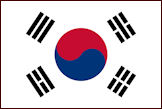
Der Ramwong-Sänger Benjamin (Tumthong Chokchana) (เบญจมินทร์ (ตุ้มทอง โชคชนะ), 1921 - 1994) leistet sechs Monate Militärdienst mit den Thai-Truppen in Korea. Daraus entstehen Songs wie:
- เกาหลีแห่งความหลัง (Korea der Vergangenheit)
- อารีดัง (Aridang = Name des Koreanischen Dorfs, in dem Benjamin stationiert ist)
- เสียงครวญจากเกาหลี (Seufzer aus Korea)
Der Song (andere Sängerin) auf Spotify:
URI: spotify:track:4eKdvmFwPd17meLS3UKX8n
URL: https://open.spotify.com/track/4eKdvmFwPd17meLS3UKX8nKünstlerlink auf Spotify:
URI: spotify:artist:6PjRGUBMFTlY4UjGaeU5l7
URL: https://open.spotify.com/artist/6PjRGUBMFTlY4UjGaeU5l7
Abb.: Hülle einer späteren CD
[Fair use]
1956
Briefmarken:
1956
Abb.: ©Whisky-Reklame, 1956
[Fair use]
1956-01

Das US National Security Council sieht vor, dass das Volunteer Defence Corps (or Sor) (อส. = กองอาสารักษาดินแดน) der paramilitärischen Border Patrol Police (ตำรวจตระเวนชายแดน) als lokale Geheimdienstorganisation dienen soll.
1956-01-01

Es erscheint
Festinger, Leon <1919 - 1989> ; Riecken, Henry W. <1917 - 2012> ; Schachter, Stanley <1922 - 1997>: When prophecy fails : A social and psychological study of a modern group that predicted the destruction of the world. -- Minneapolis : University of Minnesota Press, 1956. -- 256 S. ; 23 cm
Abb.: Einbandtitel der Ausgabe 1964Das Buch ist wegweisend für das Verständnis messianischer und eschatologischer Bewegungen wie der Phu-mi-Bun-Bewegungen [ผู้มีบุญ] Thailands.
1956-01-03


Bei Ulan Bator (Mongolei) wird das letzte Teilstück der 6500 km langen Eisenbahnlinie Moskau - Beijing eröffnet.
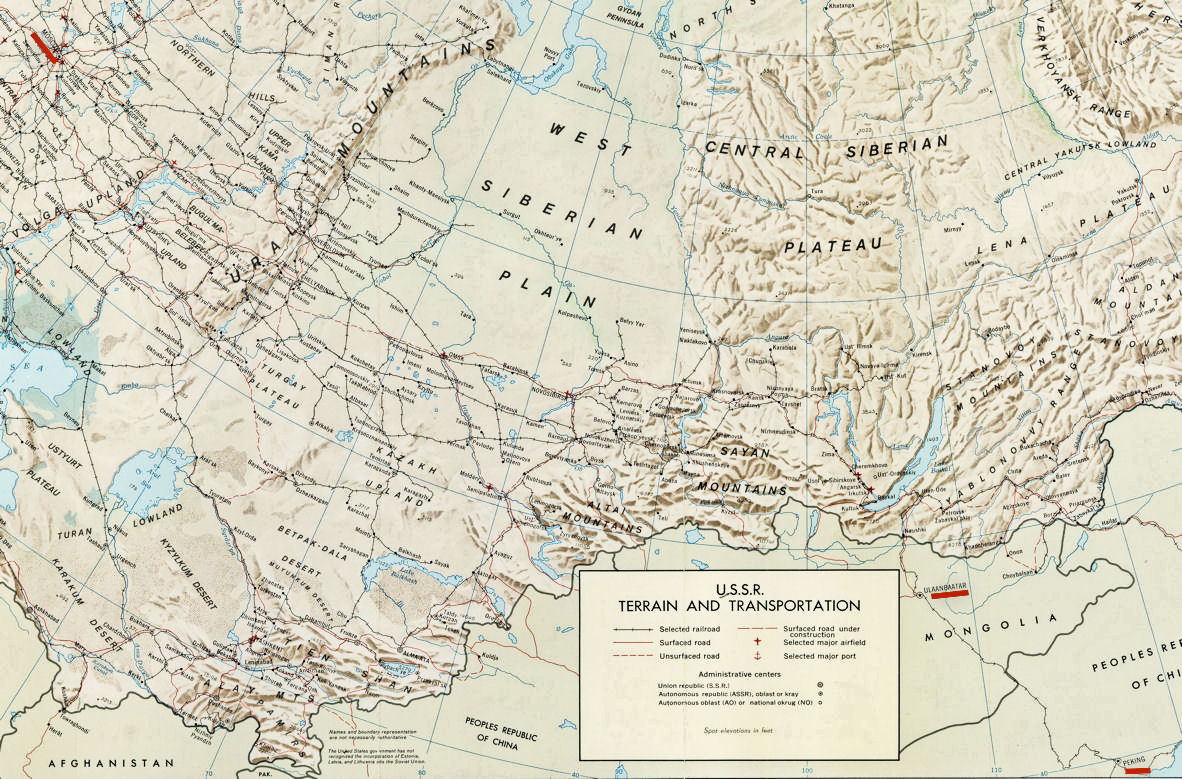
Abb.: Moskau - Ulan-Bator - Beijing
[Bildquelle: CIA. -- Public domain]
1956-01-11
Der Gouverneur von Bangkok setzt den Kilopreis für Reis auf 20 Baht fest. Der Marktpreis ist 37 Baht. Der verbilligte Reis wird von der Regierung direkt an den Endverbraucher verkauft.
1956-01-24

Die Bundesrepublik Deutschland hat ihre Gesandtschaft in Bangkok zur Botschaft erhoben. Horst Böhling ist (bis 1959) erster Botschafter.
"Horst Böhling (* 15. November 1908 in Montigny bei Metz; † 24. August 1999 in Bonn) war ein deutscher Diplomat. Leben
Horst Böhling trat 1930 in den auswärtigen Dienst ein, 1934 wurde er an der Universität Jena mit der Arbeit Chinesisches Sachenrecht: nach dem modernen Zivilgesetzbuch und Bodengesetz mit europäischen Rechten verglichen unter Berücksichtigung des alten chinesischen Rechts promoviert. Böhling trat 1938 in die NSDAP und die SS ein und wurde 1939 als Legationssekretär an die Botschaft des Deutschen Reichs in Shanghai (上海) entsandt. 1940 wurde er als Kulturreferent an die Botschaft des Deutschen Reichs in Peking (北京) entsandt.[1] Von 1941 bis 1944 war er an der Botschaft des Deutschen Reichs bei Wang Jingwei (上海, 1883 - 1944) in Nanjing (南京) akkreditiert.
Von 1946 bis 1950 arbeitete er als Hochschullehrer an der Tongji-Universität (同濟大學) in Shanghai. Von 1955 bis 1959 war er Deutscher Botschafter in Thailand, danach im Auswärtigen Amt in Bonn tätig. Von 1961 bis 1970 war Böhling Deutscher Botschafter in Malaysia.
Ehrungen
- 1969: Großes Verdienstkreuz der Bundesrepublik Deutschland"
[Quelle: https://de.wikipedia.org/wiki/Horst_B%C3%B6hling. -- Zugriff am 2016-01-02]
1956-01-26

Tod von Somdej Phramahavirawong (Uan Tisso) (สมเด็จพระมหาวีรวงศ์ (อ้วน ติสฺโส), 1868 - 1956).
Abb.: Somdej Phramahavirawong (Uan Tisso) (สมเด็จพระมหาวีรวงศ์ (อ้วน ติสฺโส))
[Bildquelle: th.Wikipedia. -- Public domain]
"The sangha authorities had always gone along with government policies, whether issued by the monarchy or the military. The sangha head of Isan [อีสาน] believed—as did the Bangkok elite—that most people in the Northeast were poor because they lacked the drive to make money. Somdet Uan [สมเด็จพระมหาวีรวงศ์ (อ้วน ติสฺโส), 1868 - 1956] was known for his articles and books advocating government policies. One of his books, Sap nai din, sin nai nam (Bounty in the earth, treasure in the water), encouraged people to work harder by clearing forests and expanding their paddy fields and orchards. One of Uan’s personal mottoes was "We must transform the forest into a town, " a slogan that was hailed as progressive at the time. Uan used the motto in an article urging monks in the Northeast to implement government policies. In this article he asked administrative monks in the Northeast to take on the role of community leaders. Fellow Isan monks, senior as well as junior, I urge you to advise laypeople to follow the right livelihood according to the guidelines laid out by the director-general of the Ministry of Agriculture. Monks should lead people to dig ponds, construct roads, and build dams. Do whatever work you can, provided it does not violate the book of discipline [vinaya].
Basically, monks are teachers. We can’t expect people to give donations if they don’t have anything to give. So, first we must teach them to make a living by encouraging them to extract the treasure in the earth and in the water; that is, to turn the land into rice fields and orchards. These treasures can be found all over the region if people are diligent."
[Quelle: Kamala Tiyavanich [กมลา ติยะวนิช] <1948 - >: Forest recollections : wandering monks in twentieth-century Thailand. -- Honolulu : Univ. of Hawai’i Pr., 1997. -- ISBN 0824817818. -- S. 199f. -- Faire use]
1956-01-27

Es erscheint die Single "Heartbreak Hotel" des US-Rock n' Roll Musikers Elvis Presley (1835 - 1977). Dieser "im authentischen Shout-Blues-Stil vorgetragene Song ist der erste Pop-Hit von Elvis Presley." (Wikipedia) Das thailändische Königspaar wird 1960 In Kalifornien (USA) Elvis Presley treffen.
Der Song auf Spotify:
URI: spotify:track:6xNwKNYZcvgV3XTIwsgNio
URL: https://open.spotify.com/track/6xNwKNYZcvgV3XTIwsgNio
Abb.: Plattentitel der deutschen Erstpressung
[Bildquelle: Wikipedia. -- Public domain]
1956-02
Thai Employment Assistance Act. Jede Firma oder Wirtschaftsorganisation mit über 9 Beschäftigten kann verpflichtet werden, bis zu 50% Thai-Staatsbürger zu beschäftigen
1956-02
Sanam Luang (สนามหลวง), Bangkok: Hungerstreik des Hyde Park Movement für für eine demokratische Reform.
Abb.: Lage des Sanam Luang (สนามหลวง)
[Bildquelle: OpenStreetMap. -- Creative Commons Lizenz (Namensnennung, share alike)]
1956-02

Die Chinesen Thailands halten öffentliche Riten für die verstorbene Großmutter des Königs, Savang Vadhana (พระเจ้าลูกเธอ พระองค์เจ้าสว่างวัฒนา, 1862 - 1955) ab. Aus diesem Anlass gibt der König einer großen Gruppe einflussreicherr Chinesen eine Audienz.
1956-02-15
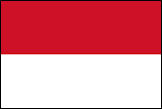
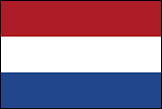
Indonesien kündigt einseitig die Union mit den Niederlanden.
1956-02-16
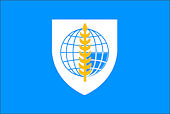
In Thailand finden eine Woche lang die Übungs-Manöver SEALINK von SEATO-Truppen statt, die die Reaktion auf eine Invasion Thailands simulieren.
1956-02-21

Der Parlamentsabgeordnete von Si Saket (ศรีสะเกษ), Thep Jotinuchit und weitere 11 Personen werden verhaftet, da sie Rotchina besucht hatten. Thep ist der Vorsitzende der Economists Party.
Abb.: Lage von Si Saket (ศรีสะเกษ)
1956-02-25

Auf dem 20. Parteitag der Kommunistischen Partei der Sowjetunion (KPdSU) verurteilt Nikita Sergejewitsch Chruschtschow (Никита Сергеевич Хрущёв, 1894 - 1971) , Erster Sekretär der KPdSU, den Terror Josef Stalins (Иосиф Виссарионович Сталин, 1878 - 1953). . Beginn der Entstalinisierung.
Abb.: Nikita Sergejewitsch Chruschtschow (Никита Сергеевич Хрущёв): Wahlplakat der CDU 1961
[Bildquelle: Archiv für Christlich-Demokratische Politik / Wikimedia. -- Creative Commons Lizenz (Namensnennung, share alike)]
1956-03
Wahlgesetz. Im Unterschied zum Wahlgesetz von 1951 besitzen jetzt auch Thai-Bürger mit einem ausländischen (d.h. meist: chinesischem) Vater das passive Wahlrecht.
1956-03-02

Die australische Fluglinie Qantas verkürzt die Flugzeit Sydney - London um 20 Stunden auf 54 Stunden: statt einer Übernachtung in Singapur fliegt sie jetzt über Jakarta und Bangkok. Flugzeugtyp: Super Constellation.
Abb.: Qantas Lockheed L-1049 Super Constellation, London (von Australien kommend) 1955
[Bildquelle RuthAS / Wikipedia. -- Creative Commons Lizenz (Namensnennung, share alike)]
1956-03-09
Ministerpräsient Phibun ruft die Männer und Frauen dazu auf, die Bevölkerung Thailands auf 40 Millionen zu bringen. Er sagt: "Unverheiratete Männer und Frauen sind unproduktive Konsumenten." Mutterschaft ist eine nationale Pflicht der Frauen. Seine Gattin La-aide Bhandhukravi (ท่านผู้หญิง ละเอียด พิบูลสงคราม - พันธุ์กระวี, 1903 - 1984), Mutter von 6 Kindern, ist Präsidentin der "National Mothers, Feminine Culture Association"
Abb.: La-aide Bhandhukravi (ท่านผู้หญิง ละเอียด พิบูลสงคราม - พันธุ์กระวี)
[Bildquelle: th.Wikipedia]
1956-03-10
Eröffnungskampf im neuen Lumphini-Boxing-Stadium (สนามมวยเวทีลุมพินี)). Eintrittspreis: 7, 15 und 30 Baht. Das Stadium soll dazu dienen, Thai-Boxen als dem Thai-Volk eigentümliche Kunst zu fördern. (Offizielle Eröffnung: 1956-12-08, siehe unten).
1956-03-14
In Chonburi (ชลบุรี) werden Arbeiter aus dem Nordosten (Isan - อีสาน) wie Sklaven gehalten. Die Regierung verspricht Abhilfe.
Abb.: Lage von Chonburi (ชลบุรี)
[Bildquelle: OpenStreetMap. -- Creative Commons Lizenz (Namensnennung, share alike)]
1956-03-21 - 1958-08-17

Prinz Souvanna Phouma (ເຈົ້າສຸວັນນະພູມາ, 1901 – 1984) ist Ministerpräsident von Laos
1956-04

USA: Gründung des Institute for Defense Analyses (IDA)
Abb.: ®Logo
"Das Institute for Defense Analyses (IDA) ist eine 1956 gegründete Non-Profit-Organisation, die drei staatlich geförderte Forschungszentren (und Denkfabriken, Federal Funded Research and Development Centers, FFRDC) zur wissenschaftlichen Beratung der US-Regierung in Fragen der nationalen Sicherheit betreibt. Ihr Hauptsitz ist in Alexandria (Virginia). Dort ist auch ihr größtes Forschungszentrum, das IDA Studies and Analyses Center (SAC). Das Science and Technology Policy Institute (STPI) in Washington, D.C. berät direkt das Office of Science and Technology Policy des US-Präsidenten. Das IDA Center for Communications and Computing arbeitet mit der National Security Agency (NSA) zusammen – es arbeitet also vor allem in Kryptographie – und ist in Princeton und La Jolla ansässig. Ein weiterer Standort liegt in Bowie (Maryland). Im Hauptzentrum in Alexandria sind u. a. folgende Abteilungen angesiedelt:
- Cost Analysis and Research Division (CARD)
- Information Technology and Systems Division (ITSD)
- Intelligence Analysis Division (IAD)
- Joint Advanced Warfighting Division (JAWD)
- Operational Evaluation Division (OED)
- Science and Technology Division (STD)
- Strategy, Forces and Resources Division (SFRD)
- System Evaluation Division (SED)
Die meisten erstellten Studien sind für das Verteidigungsministerium und den Generalstab. Sie arbeiteten aber auch u. a. für das Department of Homeland Security, CIA, NASA und das FBI. Das IDA hatte 2002 rund 1300 Beschäftigte, darunter zahlreiche Wissenschaftler aus den unterschiedlichsten Disziplinen (Biologen, Wirtschaftswissenschaftler, Mathematiker, Physiker, Informatiker usw.). Beispiele sind Keith Brueckner (1924 - 2014) und James Simons (1938 - ).
Das IDA hat seine Ursprünge in der 1947 von Verteidigungsminister James Forrestal (1892 - 1949) ins Leben gerufenen Weapons System Evaluation Group (WSEG). Unmittelbarer Anlass der Gründung war 1956 eine Anfrage des Generalstabschefs an das Massachusetts Institute of Technology (MIT), eine solche zivile Organisation zu gründen.
1990 bis 2003 und ab 2006 ist der pensionierte Air-Force-General Larry D. Welch (1934 - ) der Präsident. Bis 1990 war er Generalstabschef der US Air Force. 2002 wurden sie vom Verteidigungsministerium durch Verträge mit 145 Millionen Dollar finanziert."
[Quelle: https://de.wikipedia.org/wiki/Institute_for_Defense_Analyses. -- Zugriff am 2016-05-21]
1956-04-15
Ein Flugzeug der Royal Thai Air Force wirft versehentlich (?) eine japanische 50kg-Bombe aus dem 2. Weltkrieg auf eine Songkran-Party des Prachuab Khiri Khan (ประจวบคีรีขันธ์) Officials Club ab. 30 Tote, 29 Schwerverletzte.
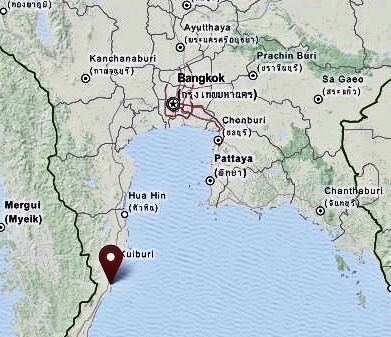
Abb.: Lage von
Prachuab Khiri Khan (ประจวบคีรีขันธ์)
[Bildquelle: OpenStreetMap. --
Creative
Commons Lizenz (Namensnennung, share alike)]
1956-04-22

Abb.: Meru für Savang Vadhana - สว่างวัฒน
[Bildquelle: th.Wikipedia. -- Public domain]Kremationszeremonien für König Bhumibol's Großmutter (สมเด็จพระพันวัสสาอัยยิกาเจ้า), Savang Vadhana (สว่างวัฒน, 1862 - 1955). Die Leichenprozession wird von Maj Gen Thanom Kittikachorn (ถนอม กิตติขจร, 1911 - 2004), dem Kommendanten der 1. Armee, angeführt.
1956-04-24
Die Regierung beschließt, in Sukhothai (สุโขทัย) eine Statue für König Ramkhamhaeng (พ่อขุนรามคำแหงมหาราช, gest. 1298), von 1279 - 1298 König von Sukhothai, errichten zu lassen.
Abb.: Lage von Sukhothai (สุโขทัย)
[Bildquelle: OpenStreetMap. -- Creative Commons Lizenz (Namensnennung, share alike)]
Abb.: Statue von König Ramkhamhaeng - พ่อขุนรามคำแหงมหาราช, Sukhothai (สุโขทัย)
[Bildquelle: Ananda / Wikipedia. -- Public domain]
1956-05


Der Südkoreaner Choi Chan Young (1927 - ) und seine Frau Dr. med. Esther (Kim Kwang Myun) kommen als Missionare nach Thailand. Es ist die erste Auslandsmission der Presbyterianischen Kirche Koreas. 1962 wird er Generalsekretär der Thailand Bible Society (สมาคมพระคริสตธรรมไทย).
1956-05

"Die Versammlung der Vertreter der "Front Freies Laos" [ແນວລາວອິດສະຫຼະ] beratschlagen in Vientiane [ວຽງຈັນ]. Die laotische Widerstandsregierung ändert ihren Namen in "Komitee Laos" (Khana Pathet Lao) [ຄະນະປະເທດລາວ] oder "Laotische Patriotische Front" (Naeo Lao Hak Sat) [ແນວລາວ ຮັກຊາດ]." [Quelle: Maha Sila Viravong [ມະຫາ ສິລາ ວີຮະວົງສ໌] <1905 - 1987>: Prinz Phetsarat : ein Leben für Laos : "Eine Biographie von Chao Maha Uparat Phetsarat" und "Die Geschichte des 12. Oktober 1945" / übersetzt aus dem Laotischen und hrsg. von Volker Grabowsky. -- Münster : LIT, 2003. -- 179 S. : Ill. ; 22 cm. -- (Periplus Texte ; 4). -- ISBN 3-8258-6492-8. -- S. 105. -- Fair use]
1956-05-01
Erstmals ist der 1. Mai öffentlicher Feiertag. Maidemonstrationszug der Sixteen-Unit Workers Group (กรรมกรสิบหกหน่วย).
1956-05-03

Kambodscha fordert von Thailand, die Grenze zwischen den beiden Ländern so anzuerkennen, wie sie in einer französischen Landkarte von 1907 gezogen ist. Thailand weigert sich und schlägt statt dessen eine Grenzziehungskommission vor. Thailand hatte die Grenze zu Kambodscha geschlossen, da Kambodschaner auf der Thaiseite Räubereien durchführten und sich dann über die Grenze zurückziehen.
1956-05-28

Das Public Relations Department ist empört über einen Artikel von Robert Alden in der New York Times vom 22. Mai. Alden hatte unter anderem auf die grassierende Korruption in Thailand hingewiesen. Das Departement verlautbarte: "there is always a certain amount of corruption in most countries." Der Polizeipräsident Phao beschränkt Aldens Aufenthaltserlaubnis in Thailand auf jeweils zwei Stunden. Im Juni wird diese Beschränkung aufgehoben.
Weitere Zitate aus Alden's Artikel: "The rule of three men [Phibun Songkhram, Sarit Thanarat, Phao Sriyanond] in Thailand is in delicate balance. Without warning the scales could shift and everything, including Thailand's pro-western position in world politics, could come crashing down. Although political intrigue here has comic opera overtones it is a deadly serious business...The United States under these circumstances has tried to maintain good relationships with all three men. It is believed that if there is an upset in the government one of the three will emerge as the new leader. In addition, the United States feels that no matter what happens, Thailand's King Bhumibol Adulyadej can unify the country [...] The United States has helped distribute hundreds of thousand of coloured pictures of the king throughout the country [...] Rumours race across Bangkok, where the King and Queen live, like brush fire. At times, it appears that an open battle is about to break out between police and the army. Then the crisis passes."
[Zitiert in: Chronicle of Thailand : headline news since 1946 / ed. in chief Nicholas Grossman. -- Bangkok : Bangkok Post, 2010. -- ISBN 978-981-4217-12-5. -- S. 86]
1956-06
Mit polizeilichem "Segen" wird ein neuer chinesische Verein gegründet: T'ai-hua Hsieh-hui. Von den 27 Vorstandmitgliedern sind 13 Linke.
1956-06

Burma: Bildung der Democratic Nationalities United Front (DNUF), eine lose Koalition von aufständischen Karen, Karenni, Pa-O und Mon.
1956-06-11

In London wird das erste Thai-Restaurant eröffnet. Es ist das erste in Europa. Besitzer ist Maj Gen MC Chatumongol Sonakul (จัตุมงคล โสณกุล). Bei einem Besuch bei seinem in England studierenden Sohn hatte er die Möglichkeit vermisst, in London auf Thai essen zu können.
Abb.: London - Thailand
[Bildquelle: OpenStreetMap. -- Creative Commons Lizenz (Namensnennung, share alike)]
1956-06-21


Thailand lockert das Handelsembargo gegen Rotchina und Nordkorea: eine Reihe nichtstrategischer Güter dürfen geliefert werden, u. a. Reis, Holz und Arzneimittel.
1956-06-23
Ministerpräsident Phibun legt, begleitet von buddhistischen und brahmanischen Zeremonien, den Grundstein zum Rathaus (Town Hall) von Bangkok.
Abb.: Lage der City Hall Bangkok (ศาลาว่าการกรุงเทพฯ)
[Bildquelle: OpenStreetMap. -- Creative Commons Lizenz (Namensnennung, share alike)]
Abb.: City Hall Bangkok - ศาลาว่าการกรุงเทพฯ
[Bildquelle: Sodacan / Wikipedia. -- Public domain]
1956-06-24
Eröffnung der Bangkok Public Library (ห้องสมุดประชาชน ของ กรุงเทพมหานคร) im Lumpini Park. Heute: Lumpini Park Discovery Library - ห้องสมุดเพื่อการเรียนรู้สวนลุมพินี.
Abb.: Plakat
[Bildquelle: http://www.libraryhub.in.th/2012/01/05/libraryhub-on-tour-at-lumpini-discovery-learning-library/. -- Zugriff am 2013-09-04. -- Fair use]
1956-06-26
Die Pressezensur wird insofern etwas gemildert, als Medien internationale Politik kommentieren dürfen, auch wenn die Kommentare über ausländische Länder nicht schmeichelhaft sind. Damit will man die Möglichkeit schaffen, gegen kritische Berichte über Thailand in der ausländischen Presse zurückzuschlagen.
1956-06-29


Es erscheint der US-Spielfilm "The King and I" mit Deborah Kerr (1921 - 2007) und Yul Brynner (Юлий Борисович Бринер, 1920 - 1985) uter der Regie von Walter Lang (1886 - 1972). Als Vorlage dient das gleichnamige Musical (1951) von Richard Rodgers (1902 - 1979) und Oscar Hammerstein II. (1895 - 1960)
Das Album auf Spotify:
URI:
spotify:album:5EFwxguMRkFvuy1PJbZN9b
URL:
https://open.spotify.com/album/5EFwxguMRkFvuy1PJbZN9b
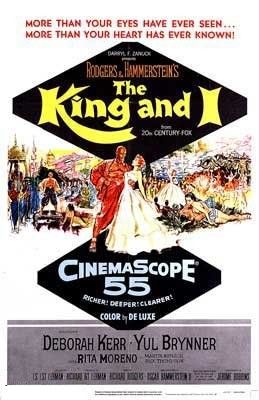
Abb.: Filmplakat
[Bildquelle: Wikiepdia. -- Fair use]
1956-07


Die Sowjetunion anerkennt. Laos.
1956-07-26
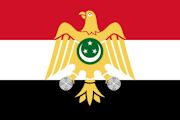



Der ägyptische Präsident Gamal Abdel Nasser (جمال عبد الناصر, 1918 - 1970) verstaatlicht den Suezkanal ( قناة السويس), obwohl die britisch-französische Konzession erst in 12 Jahren ablauft. Es kommt zur Suezkrise: 29. Oktober 1956 greifen israelische, britische und französische Truppen Ägypten an. "Durch das Eingreifen der UNO, der USA und der UdSSR wurde die Auseinandersetzung jedoch relativ rasch beendet und der Kriegsschauplatz bereits am 22. Dezember 1956 wieder geräumt. Versenkte Schiffe versperrten die Durchfahrt jedoch noch bis 1957. Am 10. April 1957 passierte das italienische Schiff Oceania als erstes den für den Schiffsverkehr wieder zugänglichen Sueskanal auf seiner Fahrt nach Australien." (Wikipedia)
Abb.: Militärische Operationen während der Suezkrise 1956
[Bildquelle: Department of History, U.S. Military Academy / Wikimedia. -- Public domain]
"We are stronger than Egypt but there are other countries stronger than us. Are we prepared to accept for ourselves the logic we are applying to Egypt? If nations more powerful than ourselves accept the absence of principle, the anarchistic attitude of Eden and launch bombs on London, what answer have we got, what complaint have we got? If we are going to appeal to force, if force is to be the arbiter to which we appeal, it would at least make common sense to try to make sure beforehand that we have got it, even if you accept that abysmal logic, that decadent point of view.
We are in fact in the position today of having appealed to force in the case of a small nation, where if it is appealed to against us it will result in the destruction of Great Britain, not only as a nation, but as an island containing living men and women. Therefore I say to Anthony, I say to the British government, there is no count at all upon which they can be defended.
They have besmirched the name of Britain. They have made us ashamed of the things of which formerly we were proud. They have offended against every principle of decency and there is only one way in which they can even begin to restore their tarnished reputation and that is to get out! Get out! Get out!"Der britische Labour-Abgeordnete Aneurin "Nye" Bevan (1897 - 1960) auf einer Anti-Suaz-Kriegs-Veranstaltung am Trafalgar Square, London. -- 1956-11-04
1956-07-30


US-Präsident Eisenhower unterschreibt das von beiden Häusern des US-Congress beschlossene Gesetz, das "In God we trust" das nationale Motto des USA ist.
Abb.: "In God we trust", Rückseite eines 1-Dollar-Scheins
[Bildquelle: Wikimedia. -- Public domain]
Abb.: "In God we trust. Spinach, pies, jam, bread, strawberries & new baby tomatoes", Maine, USA, 2007
[Bildquelle: Joe Shlabotnik. -- http://www.flickr.com/photos/40646519@N00/695093324. -- Zugriff am 2013-10-17. -- Creative Commons Lizenz (Namensnennung)]
1956-08-01 - 1956-08-10

Der laotische Ministerpräsident Souvanna Phouma (ສຸວັນນະພູມາ, 1901 - 1984) handelt mit dem Pathet Lao (ປະເທດລາວ) ein Abkommen aus:
"In only ten days of talks (August 1-10, 1956), Souvanna Phouma reached a general agreement with the Patriotic Front:
- Hostilities would cease everywhere in Laos.
- Sam Neua [ຊຳເຫນືອ] and Phong Saly [ຜົ້ງສາລີ] provinces, as well as Pathet Lao armed forces, would recognize the authority of the Royal Government.
- By-elections would be held to fill new seats to be created in the Assembly.
- A Government of National Union would be set up with the Front’s participation. This government would pledge to follow "a policy of peace and neutrality," according to the five principles of peaceful coexistence. It would maintain good relations with all countries, would not enter into any alliance, or accept foreign troops or bases in the country.
Next, Souvanna Phouma went to Peking and Hanoi, where he signed joint declarations confirming the principles agreed upon with the Patriotic Front."
[Quelle: Philippe Devillers. -- In: Laos : war and revolution / ed. by Nina S. Adams and Alfred W. McCoy. -- New York : Harper & Row, 1970. -- 482 S. ; 21 cm. -- SBN 06-090221-3. -- S. 43f. -- Fair use]
1956-08-05 - 1957-11-02

Abkommen zwischen der königlichen laotischen Regierung und dem Pathet Lao (ປະເທດລາວ) (Vientiane Agreements):
- "Joint Declaration of the Delegation of the Royal Government of Laos and the Delegation of the Pathet Lao Forces, signed on August 5, 1956, by Prince Souvanna Phouma [ສຸວັນນະພູມາ, 1901 - 1984] and Prince Souphanouvong [ສຸພານຸວົງ, 1909 - 1995].
- Joint and Final Declaration of the Delegation of the Royal Government of Laos and the Delegation of the Pathet Lao Forces [ປະເທດລາວ], signed by both princes on August 10, 1956.
- Agreement on the Measures to Be Taken for the Implementation of the Cease-Fire, concluded by the delegations of the parties in the Joint Military Committee on October 31, 1956.
- Agreement of the Joint Political Committee on the Question of Peace and Neutrality, signed on November 2, 1956.
- Agreement Between the Political Delegation of the Royal Government and the Political Delegation of the Pathet Lao Forces Relating to the Measures for the Guarantee of Civil Rights, of Nondiscrimination and of Nonreprisal for the Members of the Pathet Lao Forces and Ex-Participants of the Resistance and Measures for the Integration of the Pathet Lao Cadres and Ex-Participants in the Resistance in the Administrative and Technical Services of the Kingdom at All Levels, signed on December 24, 1956.
- Joint Communiqué of H. R. H. Prince Souvanna Phouma, Prime Minister of the Royal Laotian Government and H. R. H. Prince Souphanouvong, Representative of the Pathet Lao Forces, signed on December 28, 1956.
- Agreement Between the Political Delegation of the Royal Government and the Political Delegation of the Pathet Lao Forces on the Electoral Law, signed on February 21, 1957.
- Joint Communiqué by H. R. H. Prince Souvanna Phouma, Prime Minister of the Royal Government and H. R. H. Prince Souphanouvong, Representative of the Fighting Units of the Pathet Lao Forces, signed on November 2, 1957.
- Agreement on the Reestablishment of the Royal Administration in the Provinces of Sam Neua [ຊຳເໜືອ] and Phong Saly [ຜົ້ງສາລີ], reached between the Political Delegation of the Royal Government and the Political Delegation of the Fighting Units of the Pathet Lao, concluded on November 2, 1957.
- Military Agreement on the Integration of the Fighting Units of the Pathet Lao Forces into the National Army, signed by the representatives of the Joint Military Committee on November 2, 1957."
[Quelle: Marek Thee. -- In: Laos : war and revolution / ed. by Nina S. Adams and Alfred W. McCoy. -- New York : Harper & Row, 1970. -- 482 S. ; 21 cm. -- SBN 06-090221-3. -- S. 131ff. -- Fair use]
1956-08-10
Foremost Dairies (Bangkok) lässt sich als Ltd. registrieren. Die Firma beginnt aggressiv, Milch und andere Milchprodukte (z. B. Speiseis) zu vermarkten.
Abb.: ®Foremost Milch
[Bildquelle: Ian Fuller. -- http://www.flickr.com/photos/ianfuller/437450193/. -- Zugriff am 2011-11-04. -- Creative Commons Lizenz (Namensnennung, keine kommerzielle Nutzung)]
1956-08-11
Die Regierung stellt gewisse Wildtiere unter Schutz. Auf die unbefugte Tötung solcher Tiere steht eine Strafe bis zu 10.000 Baht und / oder zwei Jahre Haft. Der Verkauf solcher Tiere oder von Teilen davon bedarf einer Lizenz.
1956-08-19 - 1956-08-29


Staatsbesuch des laotischen Ministerpräsidenten Souvanna Phouma (ສຸວັນນະພູມາ, 1901 - 1984) in Rotchina.
1956-09
Gründung des National Council of Women of Thailand (สภาสตรีแห่งชาติ ในพระบรมราชินูปถัมภ์).
Abb.: ®Logo
1956-09-04

Die US-Firma IBM kündigt den ersten Computer-Festplattenspeicher an: IBM 350 Model 1. Thailand wird einer der größten Festplattenhersteller der Welt werden.
Abb.: IBM 350 Festplattenspeicher
[Bildquelle: ArnoldReinhold / Wikimedia. -- Creative Commons Lizenz (Namensnennung, share alike)]
1956-09-10
Die Nationalversammlung verabschiedet ein revidiertes Strafgesetzbuch. Strafen für Bestechung und Korruption und für Mitgliedschaft in kriminellen Vereinigungen sind verschärft. Erstmals ist Zuhälterei strafbar (mit bis zu 3 Jahren Haft). Homosexuelle Tätigkeiten sind nicht mehr strafbar.
1956-09-23

Thailand gestattet einer Wirtschaftdelegation der Volksrepublik China, auf dem Weg nach Kambodscha eine Nacht in Bangkok verbringt. Faktisch hält die Delegation in Bangkok nur eine Stunde, wird aber auf dem Flugplatz von mehreren Hundert Chinesen begrüßt, ebenso vom stellvertretenden Generaldirektor des Polizeidepartments und Vertretern von mindestens zwei politischen Parteien.
1956-09-25
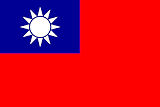
Ankunft des Botschafters der Republik China (中華民國).
1956-09-26
Die Regierung startet eine Kampagne zum Kauf thailändischer Produkte: คนไทยต้องนิยมไทย - "Thais müssen Thai [Produkte] bevorzugen!"
1956-09-27


Der Parteitag der Kommunistischen Partei Chinas (中国共产党全国代表大会) kritisiert die Entstalinisierung (десталинизация) der Sowjetunion.
Abb.: Feier von Stalins Geburtstag durch dei Kommunistische Partei Chinas 1949
[Bildquelle: Wikipedia. -- Public domain]
1956-09-28

Tod von Somdet Phra Buddhacharn Nuam (สมเด็จพระพุฒาจารย์นวม, geb. 1864), Wat Anongkaram (วัดอนงคาราม), Bangkok
Abb.: Somdet Phra Buddhacharn Nuam (สมเด็จพระพุฒาจารย์นวม)
Abb.: Lage von Wat Anongkaram (วัดอนงคาราม)
[Bildquelle: OpenStreetMap. -- Creative Commons Lizenz (Namensnennung, share alike)]
1956-09-28


Thomas Anthony Dooley III (1927 – 1961) kommt nach Laos in ärztlicher Mission.
1956-10

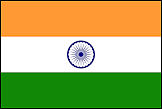
In Indien finden pompöse Feierlichkeiten zum 2.500. Jahrestag der erlösenden Einsicht des Buddha Gautama statt (2500th Buddha Jayanti). An den Feierlichkeiten nehmen u. a. der 14. Dalai Lama (བསྟན་འཛིན་རྒྱ་མཚོ་, 1935 - ) sowie der chinesische Ministerpräsident Zhōu Ēnlái (周恩来, 1898 - 1976) teil.
1956-10

Alle politischen Autoritäten Thailands lassen verstehen, dass Händler Thailands direkt mit der Volksrepublik China Handel treiben dürfen.
1956-10

"In October 1956, Phibun ordered military, police, and civilian officials on the border to cease contacts with "Chinese Nationalist troops" because they had disobeyed Taipei’s evacuation orders, engaged in illegal activities, and were mistreating Thai villagers while wrongly fighting the Burmese. He instructed all RTG [Royal Thai Government] agencies to assist Ministry of Interior efforts to suppress illegal KMT [Kuomintang - 中國國民黨] activities. In Thailand, however, an order was one thing, compliance another. Both Phibun and Phao [เผ่า ศรียานนท์, 1909 - 1960] personally briefed Chiang Rai [เชียงราย] provincial officials on the new orders. As one Thai official put it, Phibun appeared to mean what he said while "Phao’s voice said no but his face said yes. " Mutually beneficial contacts between the KMT and Thai officials on the border continued. " [Quelle: Gibson, Richard M. ; Chen, Wenhua [陳, 文華] <1944 - >: The secret army : Chiang Kai-Shek and the drug warlords of the golden triangle. -- Singapore : Wiley, 2011. -- 338 S. ;: Ill. ; 23 cm. -- ISBN 978-0-470-83018-5. -- S. 177. -- Fair use]
1956-10-05
Ministerpräsident Phibun verbietet an Wan Phra's (วันพระ, Neumond- und Vollmondtage) alle Unterhaltungen, wie Filme, Sport usw., sowie (etwas später) den Verkauf und öffentlichen Genuss von Alkohol. Buddhisten sollten die Möglichkeit haben, sich an Wan Phra's religiöser Betätigung hinzugeben ohne hedonistischen Ablenkungen ausgesetzt zu sein. Damit führt er buddhistische "blue laws" ein.
1956-10-06


Police Brigadier Rat sagt, dass die Polizei Ausländern keine politischen Aktivitäten in Thailand gestattet, das gilt in gleicherweise für chinesische Kommunisten wie Kuomintang [中國國民黨].
1956-10-09

Bangkok: Unterzeichnung des Abkommens über wirtschaftliche und technische Zusammenarbeit mit der Republik Deutschland. Sieht die Gründung des North Bangkok Technical College vor, heute: King Mongkut's University of Technology North Bangkok (KMUTNB) (มหาวิทยาลัยเทคโนโลยีพระจอมเกล้าพระนครเหนือ).
Abb.: Lage des North Bangkok Technical College
[Bildquelle: OpenStreetMap. -- Creative Commons Lizenz (Namensnennung, share alike)]
"King Mongkut's University of Technology North Bangkok (KMUTNB) (Thai มหาวิทยาลัยเทคโนโลยีพระจอมเกล้าพระนครเหนือ) ist eine öffentliche Universität in Thailand. Sie unterhält drei Campus - einen in Nord-Bangkok [1], einen in der Provinz Prachinburi[2] und einen in der Provinz Rayong (Campus befindet sich im Bau)[3]. Geschichte
- Die Institution wurde 1959 als Kooperation zwischen der thailändischen Regierung und der Bundesrepublik Deutschland gegründet als „Thai-German Technical School“.
- 1964 wurde die Schule zum „North Bangkok Technical College" hochgestuft.
- 1971 ging das College zusammen mit dem Thonburi Technical College und dem Telecommunication College Nonthaburi zusammen. Die neue Institution bildete den Campus des „King Mongkut's Institute of Technology“ in Nord-Bangkok.
- 1974 wurden drei neue Fakultäten etabliert
- 1986 spaltete sich das King Mongkut's Institute of Technology auf in drei autonome Universitäten.
- King Mongkut’s Institute of Technology Lat Krabang
- King Mongkut’s Institute of Technology Thonburi
- King Mongkut’s Institute of Technology North Bangkok
- 1995 erwarb das KMITNB Land in der Provinz Prachinburi für einen neuen Campus, „KMITNB Prachinburi“.
- 2007 wurde das Institut in den Rang einer Universität hochgestuft. Der Name wurde dabei geändert zu „King Mongkut's University of Technology North Bangkok“ (KMUTNB). [4]"
[Quelle: http://de.wikipedia.org/wiki/King_Mongkut%E2%80%99s_University_of_Technology_North_Bangkok. -- Zugriff am 2012-03-15]
1956-10-18
Der Film "The King and I" wird in Thailand definitiv verboten.
1956-10-15

Unterzeichnung eines Freundschaftsvertrags mit Burma.
1956-10-20

Erstflug des US-Mehrzweckhubschraubers Bell UH-1 Iroqois ("Huey"). Indienststellung ab 1959.
Abb.: ell UH-1H Iroqois ("Huey") der Royal Thai Airforce, 2002
[Bildquelle: TSgt. James E. Lotz, USAF / Wikimedia. -- Public domain]
1956-10-22 - 1956-12-07

König Bhumibol ist für 15 Tage buddhistischer Mönch. Während dessen ist Königin Sirikit Regentin. Während seiner Mönchszeit besucht der König mehrere Klöster in Bangkok und trifft sich auch mit chinesischen und vietnamesischen buddhistischen Mönchen. Vor seinem Eintritt in den Mönchsorden begnadigte der König 3000 Gefangene.
Abb.: König Bhumibol als Mönch mit seiner Mutter
[Bildquelle: Bureau of the Royal Household / th.Wikiepdia. -- Public domain]
1956-11
Gründung der Student Union of Thailand.
1956-11-09
Eröffnung des staatlichen Erawan Hotel (โรงแรมเอราวัณ) in Bangkok.
Abb.: Lage des Erawan Hotel (โรงแรมเอราวัณ)
[Bildquelle: OpenStreetMap. -- Creative Commons Lizenz (Namensnennung, share alike)]
Abb.: Brahma-Figur im Erawan-Schrein (ศาลท้าวมหาพรหม), Bangkok
[Bildquelle: TongJar322 / Wikipedia. -- Creative Commons (Namensnennung, share alike)]
"Während der Bauarbeiten des Erawan Hotels im Jahre 1956 ereigneten sich zahlreiche Unglücksfälle, Arbeiter starben auf der Baustelle und ein Schiff, das Marmor für das Hotel transportierte, sank auf hoher See. Die abergläubischen Arbeiter weigerten sich, weiter zu arbeiten, sie fürchteten durch die Bauarbeiten erboste Geister. Der Konteradmiral Luang Suwicharnpat, ein Experte für Astrologie, wurde um Rat gefragt und um eine Lösung für das Problem gebeten. Er stellte fest, dass die Grundsteinlegung des Hotels an einem nicht verheißungsvollen Tag geschehen sei. Er entschied, da auch der Name des neuen Hotels bereits feststand, einen Schrein zu erbauen und ihn dem Hindu-Gott Brahma zu weihen, sowie zusätzlich ein Geisterhäuschen auf dem Gelände des Hotels[1]. Als Standort wurde die nordwestlichen Ecke des Grundstücks gewählt. Als der Schrein fertiggestellt und am 9. November 1956 (nach dem thailändischen Kalender war das das Jahr 2499) eingeweiht worden war, hörte die Unfallserie auf, und das Hotel konnte in kurzer Zeit fertiggestellt werden. Im Jahre 1987 wurde das Erawan-Hotel abgerissen, an seiner Stelle 1991 das Grand Hyatt Erawan Hotel errichtet." [Quelle: http://de.wikipedia.org/wiki/Erawan-Schrein. -- Zugriff am 2011-11-04]
1956-11-11
Sanam Luang (สนามหลวง), Bangkok: Anti-imperialistische Demonstration, wird von Schlägern des Kuomintang (中國國民黨) angegriffen.
1956-11-12
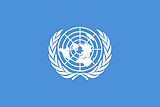
Prinz Wan Waithayakon (พระเจ้าวรวงศ์เธอ พระองค์เจ้า วรรณไวทยากร กรมหมื่นนราธิปพงศ์ประพันธ์, 1891-1976) wird zum Präsidenten der 11. Generalversammlung der UNO gewählt.
1956-11-22 - 1956-12-08
XVI. Olympische Sommerspiele in Melbourne (Australien). Thailand nimmt mit 38 Sportlern und 10 Funktionären teil.
Abb.: Lage von Melbourne
[Bildquelle: OpenStreetMap. -- Creative Commons Lizenz (Namensnennung, share alike)]
1956-12

Es erscheint:
Buddhadasa <Bhikkhu> <พุทธทาส, 1906 - 1993>: คู่มือมนุษย์ ชุด ไตรสิกขา. -- Später auch im Westen bekannt unter dem Titel "Handbook for mankind"
Abb.: Einbandtitel einer der vielen Thai-Ausgaben
Abb.: Lage von Chaiya (ไชยา)
[Bildquelle: OpenStreetMap. -- Creative Commons Lizenz (Namensnennung, share alike)]
"Buddhadasa Bhikkhu (Thai: พุทธทาสภิกขุ ausgesprochen: Put-ta-tahd Pik-ku, Geburtsname: Ngüam Panid (เงื่อม พานิช); * 27. Mai 1906 in Phumriang (พุมเรียง), Amphoe Chaiya, Südthailand; † 25. Mai 1993 in Chaiya) war einer der einflussreichsten buddhistischen Theravada-Mönche des 20. Jahrhunderts. Frühe Jahre
Buddhadasas ursprünglicher Name war Ngüam Panid (เงื่อม พานิช), er wurde am 27. Mai 1906 als ältester von drei Kindern in eine kleine Kaufmanns-Familie in Phumriang, einer kleinen Küstenstadt in der südthailändischen Provinz Surat Thani, geboren. Sein Vater hieß Sieng Panid, er war chinesischer Abstammung. Seine thailändische Mutter hieß Kluan Panid, beide betrieben einen kleinen Krämerladen, in dem Ngüam seine Kindheit verbrachte. Seine Mutter war eine tiefgläubige Buddhistin, sie lehrte ihn Verantwortung und die Kunst der Sparsamkeit. Sie wurde später einer der Hauptsponsoren des Wat Suan Mohk. In ihrer Jugend veranstalteten Ngüam und seine Brüder in der Nachbarschaft Diskussionen über buddhistische Themen.
Im Jahre 1926 wurde er traditionsgemäß und auf Wunsch seiner Mutter im Wat Mai in Phumriang zum Mönch ordiniert. Er bekam den Namen „Inthapanyo“ (der Weise). Bereits nach drei Tagen begann er, sich von den althergebrachten Konventionen zu lösen: anstatt den Laien aus den alten Schriften vorzulesen, versuchte der junge Mönch das Dhamma mit alltäglichen Ereignissen zu verbinden. Seine Art zu predigen wurden bald im ganzen Land bekannt, so dass die Predigt-Halle bald nicht mehr die vielen Leute aufnehmen konnte, die kamen, um ihm zuzuhören.
Innerhalb von zwei Jahren bestand er die Prüfungen für die beiden Grundstufen des Dhamma-Studiums (Thai: Nak Tham Tri und Nak Tham Tho). Auf Anraten seines Onkels Siang aus Chumpon zog er nach Bangkok, da er nur dort das Studium der Schriften vertiefen konnte. Inthapanyo hielt Bangkok zunächst für das „Land der Erwachten“, das Zentrum der Schriften und Gurus. Aber er wurde sehr schnell desillusioniert durch den Lärm und Dreck der Stadt, die überfüllten Tempel und die desinteressierten Mönche. Schon nach zwei Monaten war er so frustriert, dass er beinahe aus dem Mönchsorden ausgetreten wäre. Er kehrte in sein Heimatdorf zurück, wo er sich alleine das Wissen für die letzte Grund-Stufe des Studiums der alten Schriften aus Büchern beibrachte. Nach einem Jahr konnte sein Onkel ihn erneut überreden, in Bangkok das Studium der Pali-Sprache aufzunehmen. Diesmal war Inthapanyo gelassener, er konnte sich in eine ruhige Ecke zurückziehen und bekam dort Privatunterricht. Bald absolvierte er die Prüfung für die dritte Grundstufe, und wurde so ein „Phra Maha Parien“ (etwa: Pali-Gelehrter), wie er es sich gewünscht hatte.
Nach einem weiteren Jahr des Aufbau-Studiums, das er aber nur halbherzig betrieb, fiel er durch die Prüfung, was ihn endgültig davon überzeugte, der Großstadt den Rücken zuzuwenden und nach Phumriang zurückzukehren.
Gründung von Wat Suan MohkZu Zeiten des Gautama Buddha empfahl dieser seinen Schülern, in den Wald zu gehen und sich unter einen Baum zu setzen, um die letzte Wahrheit zu suchen. Genau dies wollte Inthapanyo tun. Mit Hilfe seines Bruders und einiger befreundeter Mönche fand er einen seit 80 Jahren verlassenen Tempel im Dschungel, der Wat Trapangjik genannt wurde.
Hier ließ er sich eine kleine Hütte bauen und zog im Mai 1932 dort ein. Er nannte diesen Tempel „Suan Mokkhabalarama (สวนโมกขพลาราม)“ (kurz: Suan Mohk), was so viel wie „Garten der Befreiung“ bedeutet. Im gleichen Jahr, nur einen Monat später stürzten Militärs in einem gewaltlosen Putsch den König von Thailand und errichteten eine konstitutionelle Monarchie, was Buddhadasa selbst als gutes Omen für seine Neugründung ansah.
In den ersten zwei Jahren im Suan Mohk hatte sich Inthapanyo einem Leben in völliger Abgeschiedenheit ergeben. Bis zu der Konsequenz, dass sein Bruder seine tägliche Mahlzeit am Waldrand an einen Baum zu hängen hatte, damit der Einsiedler keinem Menschen begegnen musste. Er verbrachte seine Zeit mit Meditation und dem Studium des Tipitaka, immer bestrebt, den Weg der Theravada-Waldmönche einzuhalten. Anhand des Tipitaka und eigenen praktischen Erfahrungen stellte er für die ernsthafte Meditation eine Schritt-für-Schritt-Anleitung zusammen, die er ins Thailändische übersetzte und „Folge den Fußspuren der Arahats“ nannte. Er veröffentlichte sie in dem Journal „Buddhasasana“ (Thai: Buddhismus), welches sein Bruder Dhammadasa herausgab, unter seinem neuen Namen „Buddhadasa“ (Diener des Buddha). Diesen Namen gab er sich in einem feierlichen Gelübde im August 1932: „Ich übergebe dieses Leben und diesen Körper dem Buddha. Ich bin ein Diener des Buddha, und der Buddha ist mein Gebieter. Daher werde ich fortan den Namen Buddhadasa tragen.“
In seinen späteren Jahren kamen viele ausländische Studenten in seinen Tempel, um seine Predigten zu hören und an zehntägigen Retreats teilzunehmen. Er hielt auch viele Gespräche mit Gelehrten der christlichen Kirche und auch anderer Religionen, in denen er immer betonte, dass in den Grundaussagen eigentlich alle Religionen gleich seien. Kurz vor seinem Tod im Jahre 1993 richtete er das International Dhamma Hermitage Center in der Nähe seines Tempels ein, um Nicht-Thai-Studenten eine Möglichkeit zu geben, die Lehren Buddhas und die Vipassana-Meditation zu studieren.
Buddhadasa starb am 25. Mai 1993 nach einer Serie von Herzanfällen und Herzschlägen bei der Vorbereitung einer Rede, die er zwei Tage später zu seinem Geburtstag halten wollte. Nachdem die Ärzte des Siriraj-Hospitals in Bangkok unter Protest seiner Freunde und Mitmönche wochenlang vergeblich versuchten, seine Gesundheit wiederherzustellen, stellten sie seinen physikalischen Tod am 8. Juli 1993 fest."
[Quelle: http://de.wikipedia.org/wiki/Buddhadasa. -- Zugriff am 2011-11-04]
Leseprobe aus der Einleitung:
"Rites and ceremonies of this kind have become so numerous that they now completely obscure the real Buddhism and its original purpose. Take for example the procedure of becoming ordained a monk. There has come into existence the ceremony of making gifts to the newly ordained bhikkhu Guests are invited to bring food and to watch proceedings, and as a result, there is much drunkenness and noise. Ceremonies are performed both at the temple and in the home. The new bhikkhu later leaves the Order again only a few days after having been ordained, and may become an even stronger temple-hater than he was before. It must be borne in mind that there was none of this at the time of the Buddha. It is a later development. Ordination at the time of the Buddha meant simply, that some individual, who had obtained his parent's consent, renounced home and family. He was a person who was able to close accounts at home and go off to join the Buddha and the Order of bhikkhus. On some convenient occasion he would go and be ordained, and perhaps not see his parents or family again for the rest of his life. Though some bhikkhus might go back to visit their parents again on suitable occasions, this was rare. There does exist a rule permitting a bhikkhu to go home when there is a good reason for doing so, but at the time of the Buddha this was not the done thing. Bhikkhus did not receive ordination with their parents in attendance nor did they celebrate the event as a great occasion, only to leave the Sangha again after just a few days, no better off than at first, as commonly happens in the present day.
All this presenting of gifts to newly ordained bhikkhus, this performing of ceremonies, including all sorts of celebration - this we are foolish enough to call Buddhism! Furthermore we choose to make much of it, thinking nothing of spending all our own money, or other people's on account of it. This "Neo-Buddhism" is so widespread as to be almost universal. The Dhamma, the genuine teaching that once was paramount has become so overlaid by ceremonial that the whole objective of Buddhism has been obscured, falsified and changed. Ordination, for instance, has become a face-saving gambit for young men whom people have been pointing at for never having been ordained, or a prerequisite to finding a wife (as having been a monk is considered a sign of maturity), or is done with some other kind of ulterior motive. In some places an ordination is regarded as an opportunity for collecting money for which job there are always people on hand to help. It is one way of getting rich. Even this they call Buddhism! And anyone who goes and criticizes this is considered to be ignorant of Buddhism or opposed to it."
[Quelle: Buddhadasa <Bhikkhu> <พุทธทาส, 1906 - 1993>: Handbook for Mankind / Translated from the Thai by Ariyananda Bhikkhu (Roderick S. Bucknell). -- "Looking at Buddhism". -- Online: http://www.buddhanet.net/budasa4.htm. -- Zugriff am 2011-11-04]
1956-12

Es erscheint:
Buddhadasa <Bhikkhu> <พุทธทาส, 1906 - 1993>: พุทธศาสนา กับ สังคม [Buddhismus und Gesellschaft]. -- : มหาจุฬาลงกรณราชวิทยาลัย [Mahachulalongkornrajavidyalaya], 2499-12 [= 1956-12]
"Im Jahre 1956 veröffentlichte die Buddhistische Hochschule in Wat Mahathat einen Beitrag von Phutthathat Phikkhu [พุทธทาสภิกขุ, 1906 - 1993], eines international bekannten thailändischen Mönches, der in gewisser Weise eine über den Parteiungen stehende neutrale Instanz darstellt. Der Beitrag trägt den Titel "Buddhismus und Gesellschaft" [พุทธศาสนา กับ สังคม] und unterstreicht besonders die sozialen Aspekte des Buddhismus, ohne dabei allerdings eine radikale Stellung zu beziehen, wie dies später von anderen Mönchen getan wurde. Er bedauert, daß die Menschen oftmals die Bedeutung des Buddhismus für die Gesellschaft missverstehen und nicht erkennen, dass soziales Verhalten zu den wichtigsten Forderungen des Buddhismus zählt. Dieses soziale Verhalten könne sowohl als materielle als natürlich auch als geistige Hilfe für den Mitmenschen zum Ausdruck kommen. Der Autor geht davon aus, dass die Gemeinschaft der Buddhisten den ''Gesellschaftsvertrag" anerkennen und respektieren müsse. Das bedeute: "Jeder ist durch Rechte, Aufgaben und gegenseitige Dankespflicht untrennbar mit dem anderen verbunden, ohne es zu merken. Deshalb sollte jeder daran denken, dass er die Pflicht hat, sich nützlich dem Mitmenschen gegenüber zu verhalten. Das macht die Würde des Menschen aus. Wir könnten sagen, dass derjenige nicht den Namen Mensch verdient, der gegen diesen Gesellschaftsvertrag verstößt. Deshalb müssen die Mitglieder der Gemeinschaft der Buddhisten - sowohl jene, die noch nicht erlöst sind, als auch jene, die die Erlösung als Arhats schon erreicht haben - den Gesellschaftsvertrag anerkennen und sich korrekt danach verhalten" .
Aufgrund des Gesellschaftsvertrags - so führt der Autor aus - seien alle noch nicht erlösten Menschen Schuldner gegenüber der Gesellschaft. Sie seien noch an Verpflichtungen gebunden und könnten solange das Nirvana nicht erreichen. Soziales Verhalten, das heißt die Tilgung jener Schuld aus dem Gesellschaftsvertrag, sei nach buddhistischer Vorstellung die Voraussetzung dafür. Nur die Arhats oder die Bodhisattvas seien dieser Schuld gegenüber der Gesellschaft ledig. Doch die Fülle ihrer verdienstvollen Werke fließe als Mettā (liebende Güte) und Paññā (Weisheit) über auf die menschliche Gesellschaft, ohne daß der Arhat noch irgendeine Schuld aufgrund des Gesellschaftsvertrages zurückzuerstatten hätte."
[Quelle: Skrobanek, Walter <1941 - 2006>: Buddhistische Politik in Thailand : mit besonderer Berücksichtigung des heterodoxen Messianismus. -- Wiesbaden : Steiner, 1976. -- 315 S. ; 24 cm. -- (Beiträge zur Südasienforschung ; 23). -- ISBN 3-515-02390-9. -- Zugl.: Heidelberg, Univ., Diss., 1972. -- S. 141f.. -- Mit Erlaubnis des inzwischen verstorbenen Autors]
1956-12-03
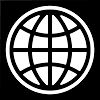
Thailand wird Mitglied der International Finance Corporation (IFC)
1956-12-06/15/16


König Bhumibol spielt im Palast zusammen mit Benny Goodman (1909 - 1987) Jazz. Goodman ist auf einer vom US State Departement und ANTA (American National Theater and Academy) gesponserten Tour durch Südostasien und Ostasien. Goodman und seine Band treten auch am 14. und 15. im Lumphini Park (สวนลุมพินี) vor je ca. 10.000 Zuhörern auf. Die Aufführungsbedingungen sind denkbar schlecht, da dort gleichzeitig ein Jahrmarkt (Constitution Fair) stattfindet.
Künstlerlink auf Spotify:
URI: spotify:artist:1pBuKaLHJlIlqYxQQaflve
URL: https://open.spotify.com/artist/1pBuKaLHJlIlqYxQQaflveZusammen mit Goodman treten u.a. auf
- Dottie Reid, Sängerin, u.a. mit einem Thai-Song
- Rex Peer, Posaune
- Jack Rains, Posaune
Kurt Mueller macht mit zwei Mikrophonen Aufnahmen von den öffentlichen Konzerten. Sie erscheinen 1997 auf CD bei TCB mit folgenden Nummern
- Let's Dance
- Don't Be That Way
- King Porter Stomp
- Trigger Fantasy
- Roll 'Em
- One O’clock Jump
- Down South Camp Meeting
- Yarm Yen [ยามเย็น] / In The Evening
- Sugar Foot Stomp
- Big John Special
- Flying Home
- The World Is Waiting For The Sunrise
- Oh Lady Be Good
- Sai Fon [สายฝน] / Falling Rain
- Stompin' At The Savoy
- Thai Royal Anthem [สรรเสริญพระบารมี]
1956-12-08
Offizielle Eröffnung des Lumphini Boxing Stadium (สนามมวยเวทีลุมพินี).
Abb.: Lage des Lumpinee Boxing Stadium (สนามมวยเวทีลุมพินี)
[Bildquelle: OpenStreetMap. -- Creative Commons Lizenz (Namensnennung, share alike)]
Abb.: Lumpinee Boxing Stadium (สนามมวยเวทีลุมพินี)
[Bildquelle: Anand. -- http://www.flickr.com/photos/lostwithoutwords/633955842/. -- Zugriff am 2011-11-14. -- Creative Commons Lizenz (Namensnennung, keine kommerzielle Nutzung, share alike)]
"Lumpinee Boxing Stadium (Thai: สนามมวยเวทีลุมพินี) is an indoor sporting arena located in Bangkok, Thailand. Opened more than a decade later than Rajadamnern Stadium (สนามมวยราชดำเนิน), the Lumpinee is run by Royal Thai Army on behalf of Thai Government. It has become the symbol of modern Muay Thai (มวยไทย). Only Rajadamnern Stadium rivals the prestige of holding the title of "Muay Thai Champion of Lumpinee". The ranking system and championship titles are held from Flyweight (111 lb) up to Welterweight (147 lb). [1] Muay thai contests are held on every Tuesdays, Fridays and Saturdays. The fights usually start around 6.00 p.m. Ticket prices range from 200 to 2,000 Baht.[1]
HistoryGeneral Praphas Charusathien (ประภาส จารุเสถียร, 1912 - 1997) was the driving force behind the construction of the Lumpinee Stadium, a second national stadium built in Thailand after Rajadamnern. Lumpinee opened its doors on December 8, 1956. The stadium is operated by Thailand’s Army Welfare Department of the Royal Thai Army (กองทัพบกไทย), all proceeds from the fights go towards supporting the various departments of the Thai Army. [2]
Currently there are eleven promoters presented with the responsibility of bringing fighters to fight in the stadium. The rules are the same as in Rajadamnern with the boxers having to weigh more than 100 lb (45.4 kg), be aged over 15 years and the weight difference between the boxers is not allowed to be more than a 5 lb (2.3 kg). Women are not allowed to fight in the stadium or enter the ring. [3]
One of the most famous Lumpinee Champions was Dieselnoi Chor Thanasukarn (ดีเซลน้อย ช.ธนะสุกาญจน์, 1961 - ) who reigned without defeat in the early 1980s, holding the Lightweight Title for 4 years, he was eventually forced to retire because of simply running out of opponents.[4]
[...]Gambling
Lumpinee is one of the few places in Thailand where gambling is permitted and it takes place at the second level. The betting is done by hand-signals, as in a stock exchange trading floor. Often such signs are misunderstood by one side and additional fights may erupt outside the ring between gamblers. The security service at Lumpinee is managed by armed Military Police officers. Foreigners usually occupy the expensive ringside seats, while gamblers and aficionados prefer the second or third ring of seats upstairs.
References
- "Stadiums in Thailand". www.muaythaionline.org. Retrieved 2008-01-25.
- "History of Lumpinee". www.wmtc.nu. Retrieved 2008-01-20.
- Mallon, Scott. "Lumpini Stadium Turns Fifty". www.thesweetscience.com. Retrieved 2008-01-25.
- "Lumpini Stadium History". www.wmcmuaythai.org. Retrieved 2008-01-25."
[Quelle: http://en.wikipedia.org/wiki/Lumpinee_Boxing_Stadium. -- Zugriff am 2011-11-14]
1956-12-31
Sanam Luang (สนามหลวง), Bangkok: Neujahrsfeier der Sixteen-Unit Workers Group (กรรมกรสิบหกหน่วย) mit anti-imperialistischer Demonstration.
Abb.: Lage des Sanam Luang (สนามหลวง)
[Bildquelle: OpenStreetMap. -- Creative Commons Lizenz (Namensnennung, share alike)]
ausführlich: http://www.payer.de/thailandchronik/ressourcen.htm
Zu Chronik 1957